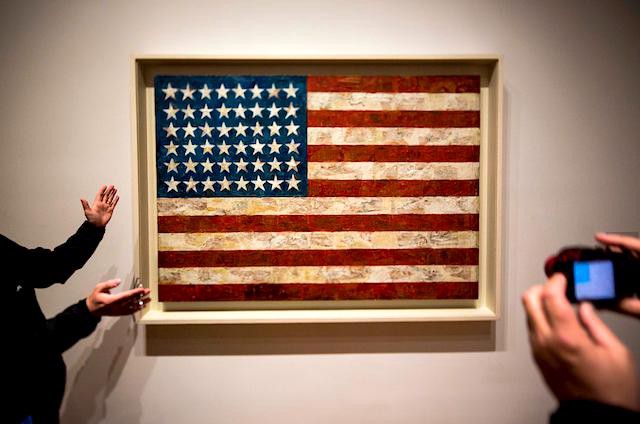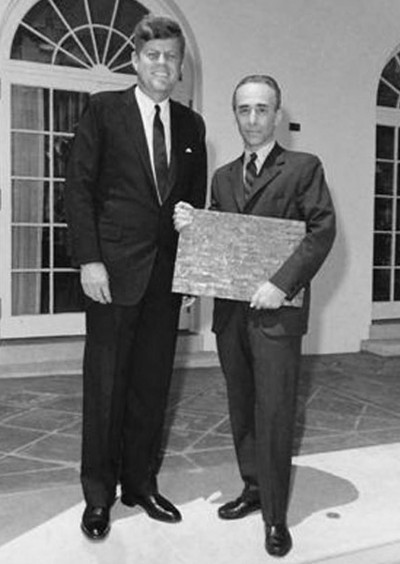Who's Looking Out For Jasper Johns?
by Brendan O’Connor

Two decades ago, Martin Lang paid £100,000 for what he thought was a painting by Marc Chagall — a reclining nude, dated 1909–10. Recently, at his son’s behest, Lang submitted the painting to the producers of the BBC art program “Fake or Fortune?” Unfortunately for Lang, “Fake or Fortune”’s analysis came up fake: it showed that the painting’s blues and greens used pigments only developed in the 1930s.
Upon this discovery, Lang was issued a writ by the Chagall Committee — based in Paris and headed by Chagall’s two granddaughters — which is the only body with the authority to declare the authenticity of a Chagall. Now that Lang’s painting has been shown to be a fake, what does the Chagall Committee want with it?
Well, they want to burn it.
If the committee finds a piece to have been forged it should, according to some magical and arcane and very, very French law, be burned in front of a magistrate. Italy and China also sometimes order the destruction of fakes. It’s rarer in America, although already this year work by Richard Prince was ordered destroyed — not because it was fake but because it was said to infringe on copyright.
But sometimes you can’t get your hands on your own fakes.

Jasper Johns is now 83 years old, and he lives in Sharon, Connecticut. At the end of January, he came back down to Manhattan to testify in federal court against Brian Ramnarine, a 60-year-old native of Guyana and the former owner of Long Island City’s Empire Bronze Art Foundry. Ramnarine is accused of wire fraud. He tried to sell a fake Jasper Johns sculpture that he made, for $11 million.
Johns’ first “Flag” painting was done in the mid-1950s, in a fertile period when he was involved with Robert Rauschenberg and they were working in studios down at the foot of the Brooklyn Bridge; that “Flag” is now owned by the Museum of Modern Art. “White Flag,” done in the late 50s, was sold to the Metropolitan Museum of Art for an undisclosed sum in the millions of dollars. “Three Flags” you have probably seen at the Whitney. You have probably not seen the one owned by Steve Cohen.
In 1960, Johns made a “Flag” painting using a material called “sculpt metal.” Sculpt metal, as described by Johns in his witness testimony, is a kind of a lacquer that has the consistency of toothpaste. “It can be spread with a knife or with your finger or it can be thinned with a solvent and brushed on some material,” he said. “When it dries it can be polished and it resembles metal.” That was when Johns was being helpful on the stand. (To defense lawyers, he was less so: Q. “Much of your work is valued in the millions of dollars?” A: “Is that a question?”)
Johns gave the sculpt-metal “Flag” to Rauschenberg; shortly thereafter he borrowed it back to use it to make a sculpture. Because he had done the piece using sculpt metal, Johns was able to take a mold of the surface of the painting. He poured plaster into the mold; he then removed the plaster and had a ‘positive’ of the surface of the painting, which he gave to a foundry. The foundry made four copies of that positive in bronze. One would be given to John F. Kennedy.

Two decades later, Johns had another mold made — this one a negative — by “a very fine mold maker,” a woman he said had been working on the restoration of the Statue of Liberty with her father.
(A positive mold — such as the one used to create the first four copies of the sculpt-metal painting — is pressed into the ground, creating a depression which is then filled with metal. A negative mold is one into which metal is poured directly. Now you know!)
Sometime around 1987, Johns brought that mold to the Polich Tallix foundry. They cast a “Flag” sculpture in silver and returned the mold to Johns. A few years later, sometime around 1990, Johns began to consider casting a “Flag” sculpture in gold.
Johns approached Brian Ramnarine with the idea — they had worked together before on “a number of projects,” Johns said. Johns lent the mold to Ramnarine, who made a wax cast — a kind of a test run — which he delivered to Johns and which Johns kept in his refrigerator. Ramnarine did not, however, return the mold.
Sometime in the early 90s, an art dealer came to Johns with a bronze copy of “Flag,” asking him to authenticate it. Johns refused and sent the man away, though not before crossing out a fake signature on the back of the sculpture.
At the trial, the prosecutor showed Johns this forged sculpture once again.
“Is this your sculpture?” he asked.
“Its source is mine, from my work,” said Johns. “But it’s not mine.”

The art dealer who visited Johns wrote him a series of “increasingly desperate” — Johns’ words — letters from 1994 to 1996. In 1995 he even sent Johns a portrait that he (or someone else) had done of the artist. Johns responded twice, denying to authenticate the sculpture both times. At one point he sent his longtime assistant James Meyer to retrieve the mold, but Meyer was unsuccessful.
The identity of this art dealer — now deceased — is unclear. Johns remembers him as a relative of Ramnarine’s but didn’t use his name in court. During the cross examination, however, one of the defense attorneys used the name “Mike Harpul” to refer to this individual. In its trial coverage the Associated Press declined to use a name, referring only to a “relative” of Ramnarine’s; the Wall Street Journal, however, does give this individual a name, albeit in a different form than that recorded in the court’s official transcript: “Sendupt Harpaul.”
In any event, after spending the previous half-decade denying this man’s — and, presumably, by proxy, Brian Ramnarine’s — requests to authenticate the bronze “Flag” sculpture, Johns got Ramnarine’s wax cast out of his fridge and took it to a woman named Paige Tooker, who used it to cast a “Flag” in white bronze.
At some point in the intervening years, Ramnarine forged a second “Flag” sculpture — a fact of which Johns only became aware after he was informed by the FBI in 2010. This sculpture was not only inscribed with a signature but also identified as an artist proof: “AP 1/1.”
Ramnarine (or someone else) also forged Johns’ signature on documents purporting to authenticate the sculptures. It’s possible that it was someone else because Ramnarine is illiterate.
Four days after Johns testified against him, Ramnarine changed his plea.

Brian Ramnarine faces up to 80 years in prison and as much as nearly a million dollars in fines. He has pleaded guilty to three counts of wire fraud, and it is up to the judge to decide whether he will serve his sentences for each concurrently or consecutively. The sentencing will take place May 30th at 10 a.m., if you are into that kind of thing.
But why is the penalty so steep? For one thing, wire fraud is a felony — and a federal offense at that — and Ramnarine copped to three counts of it. The feds had offered him a deal in 2012 but he declined. Whatever they offered him then is gone now. Moreover, Ramnarine was already under investigation for the first offense (the charges relating to Johns) when he committed the alleged fraud relevant to the second two counts.
It’s odd that Ramnarine turned down the deal offered to him in 2012 — after all, he took a deal in 2003, the first time he was staring down federal charges.
“He’s a tremendously mean person,” one former employee told the Queens Chronicle back in 2003, when Ramnarine was first busted selling fakes. “He has absolutely no shame.”
When he changed his plea on the 27th, Ramnarine tried to introduce a new character to the story.
“I met an art broker, Adam Stolpen, and he was trying to sell the American ‘Flag,’ and I said, ‘Fine,’” Ramnarine said.
The judge wasn’t having it.
But why would an art broker be interested in a forgery? Particularly when, in Johns’ case, there was so much legitimate work on the market already, and what’s more, quite a bit of stolen work, as Johns’ studio assistant James Meyer — the fellow that Johns had once sent to retrieve the forgery — was accused of sneaking at least 22 works straight out of the studio.
“Profit margin on fakes and stolen art means it comes in handy when business is tough,” Paul Hendry told me over Skype. “Turbo Paul,” as he is known, is the proprietor of the blog Art Hostage and claims to be a former trafficker of stolen art. The sale of forgeries, fakes, and unauthorized copies, Hendry said, “can be a welcome bonus because those deals are mostly cash oriented, off the books.” In other words, fakes cost little, and sell quick.
“Temptation, human nature of something for nothing depicts why the allure of a quick buck overrides sense,” he said.
And what’s an artist to do? Johns’ art dealer, Leo Castelli, died in 1999, and he hasn’t had a guiding relationship like that since, though he works in a limited capacity with Matthew Marks Gallery. So when Johns was first approached by Harpul, or Harpaul, or whoever this art dealer was with the forged “Flag” sculpture, he contacted the Art Dealers Association in New York.
“They were not extremely helpful,” he said.
Brendan O’Connor is a reporter in New York. Photo by Parker Miles Blohm.
